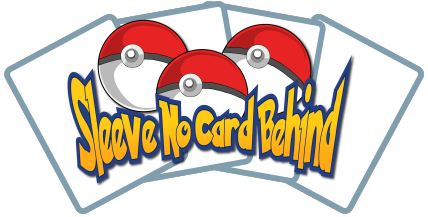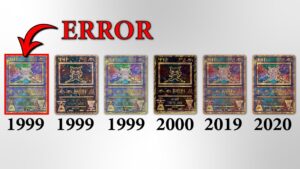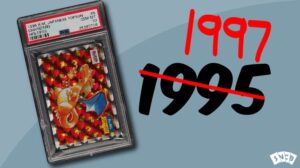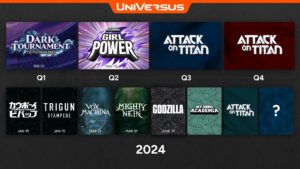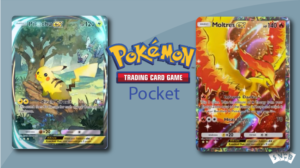How to value your Pokémon cards
-
By: Oliver Copeland
- Published:
- Last Updated: February 19, 2024
Are you a Pokémon card collector? Or maybe you’re just starting out and aren’t sure how to value your cards. Whatever the case, you’ll want to read this blog post! We’ll go over different factors that can affect the value of your Pokémon cards, so you can make sure you’re getting the best bang for your buck. So what are you waiting for? Start reading!
Step 1: Identify the card(s)
Type the name of the card and its number into Google to identify the card. For example, ‘Alakazam 1/102’
The first step may sound obvious, but many collectors actually skip this. For example, there are hundreds of Pikachu cards, and even more modern ones like Buzzwole have more than a dozen different cards.
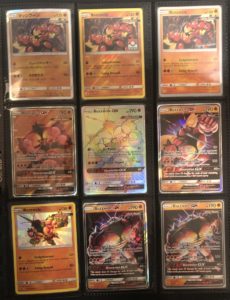
Each card (with few exceptions) will belong to a set. Sets come out a few times a year, so since 1996… Well, there’s a lot. The set that a card belongs to is usually noted by the set symbol on the card. It can be found on the bottom left or right, or on older cards, the bottom right of the illustration box.
Every card will have a number either bottom right or bottom left, indicating its place in the set. For example, ‘Alakazam 1/102’. Type this into Google, and you should be able to identify the set that the card came from, along with information related to the specific card like the release date and market prices.
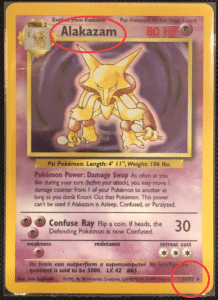
Step 2: Determine the condition
Card conditions range from Damaged (DM), Heavily played (HP), Moderately played (MP), Lightly played (LP), and Near mint (NM).
Card condition is the biggest factor when determining a card’s value. For example, a first edition Base set Charizard can go for as little as $3,000 when in poor condition, but $250,000+ when near mint.
TCGPlayer has a great to-the-point guide on card condition, click here to check it out. Once you’ve been able to determine the condition of the cards you’ve chosen, you can add that detail to your eBay search.
Step 3: Search eBay sold listings
Go to eBay and search the card name, followed by the set number, followed by the condition. For example, ‘Alakazam 1/102 MP’. After that, just check the ‘sold listings’ box.
There are a number of sites that can help you find the value of your cards like tcgplayer.com trollandtoad.com or pokemonprices.com. These sources are great if you’re looking for a ballpark number. However, I find that the most reliable and simple way to find values is through eBay. eBay is the largest market for buying and selling Pokémon cards.
Now, don’t go looking through listings yet. Just like any buy and sell market, people can set whatever price they want. This often leads to misinformation, as someone will ask a ridiculous amount for a cheap card and mislead the people who see the listing into thinking that its value is high.
People list their cards for crazy prices. This is why we go to the search filters and check the box that says “sold listings”. What this does is show us only the listing that have been sold. This way, you can see what people are actually paying for your cards.
So, go to eBay and search the card name, followed by the set number, followed by the condition. For example, ‘Alakazam 1/102 MP’. After that, just check the ‘sold listings’ box and you’ll see exactly what your card is worth and all of the most recent sales.
Step 4: Additional factors to consider
The first three steps should cover most cards, but there are some additional factors to take into consideration. By now you should know how to search your card up on Google, so do that and compare images with the card in your hand.
Some cards will have special stamps that say ‘STAFF’ or ‘PRERELEASE’ on the card’s illustration. Sometimes the card will be a ‘reverse holo’. This is when the card is holofoil and the illustration box is not. World tournament cards will have a unique backing to the card. Also, check to see if your card is a ‘first edition’. If it is, there will be a stamp at the lower left of the illustration box.
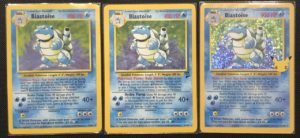
This image of three Blastoise cards is a great example. As you can see, they all look the same at a glance. However, the values vary greatly. Furthermore, the Blastoise on the left and the right have the same set number 2/102. The difference here is that one has the Pikachu stamp on the card. The one with the Pikachu stamp is worth <$5 while the one on the left is worth >$150.
The point is, there are a lot of variations of each card that might not be obvious to a newbie. Another option is to type into Google, ‘[Your card] variations’. This should result in a list of any variations like the staff promo etc.
Where to sell your cards
When it comes to selling cards, you have two routes to consider: local or online.
Local options include Facebook Marketplace, Craigslist, and your local card shops. The buy n’ sells will depend mostly on your area and the health of the hobby in your area. Selling your cards to a card shop is the quickest option, but you won’t receive market value as the shop has to make a profit as well.
Online options are more abundant, as there are dozens if not hundreds of sites to choose from. However, one ranks above all. eBay, as we stated above, is the largest card market online and you’re guaranteed to receive close to market value.
Conclusion
There you have it, a quick method to determine the value of your cards, plus a quick tip on selling them. The world of Pokémon cards is huge and ever-expanding. It seems as though the more you learn, the more questions you have. Determining the value of your cards is probably one of the quickest ways to learn about them, and sometimes leads to discovering more valuable cards in your collection. So dive in!
